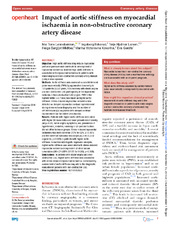| dc.contributor.author | Lønnebakken, Mai Tone | en_US |
| dc.contributor.author | Eskerud, Ingeborg | en_US |
| dc.contributor.author | Larsen, Terje H | en_US |
| dc.contributor.author | Midtbø, Helga Bergljot | en_US |
| dc.contributor.author | Kokorina, Marina Victorovna | en_US |
| dc.contributor.author | Gerdts, Eva | en_US |
| dc.date.accessioned | 2020-08-07T13:00:11Z | |
| dc.date.available | 2020-08-07T13:00:11Z | |
| dc.date.issued | 2019 | |
| dc.Published | Lønnebakken MT, Eskerud I, Larsen TH, Midtbø HB, Kokorina MV, Gerdts E. Impact of aortic stiffness on myocardial ischaemia in non-obstructive coronary artery disease. Open heart. 2019;6:e000981 | eng |
| dc.identifier.issn | 2053-3624 | |
| dc.identifier.uri | https://hdl.handle.net/1956/23577 | |
| dc.description.abstract | Objective: High aortic stiffness may reduce myocardial perfusion pressure and contribute to development of myocardial ischaemia. Whether high aortic stiffness is associated with myocardial ischaemia in patients with stable angina and non-obstructive coronary artery disease (CAD) is less explored. Methods: Aortic stiffness was assessed as carotid-femoral pulse wave velocity (PWV) by applanation tonometry in 125 patients (62±8 years, 58% women) with stable angina and non-obstructive CAD participating in the Myocardial Ischemia in Non-obstructive CAD project. PWV in the highest tertile (>8.7 m/s) was taken as higher aortic stiffness. Stress-induced myocardial ischaemia was detected as delayed myocardial contrast replenishment during stress echocardiography, and the number of left ventricular (LV) segments with delayed contrast replenishment as the extent of ischaemia. Results: Patients with higher aortic stiffness were older with higher LV mass index and lower prevalence of obesity (all p<0.05), while angina symptoms, sex, prevalence of hypertension, diabetes, smoking or LV ejection fraction did not differ between groups. Stress-induced myocardial ischaemia was more common (73% vs 42%, p=0.001) and the extent of ischaemia was larger (4±3 vs 2±3 LV segments, p=0.005) in patients with higher aortic stiffness. In multivariable logistic regression analysis, higher aortic stiffness was associated with stress-induced myocardial ischaemia independent of other known covariables (OR 4.74 (95% CI 1.51 to 14.93), p=0.008). Conclusions: In patients with stable angina and non-obstructive CAD, higher aortic stiffness was associated with stress-induced myocardial ischaemia. Consequently, assessment of aortic stiffness may add to the diagnostic evaluation in patients with non-obstructive CAD. | en_US |
| dc.language.iso | eng | eng |
| dc.publisher | BMJ | eng |
| dc.rights | Attribution-Non Commercial CC BY-NC | eng |
| dc.rights.uri | http://creativecommons.org/licenses/by-nc/4.0/ | eng |
| dc.title | Impact of aortic stiffness on myocardial ischaemia in non-obstructive coronary artery disease | en_US |
| dc.type | Peer reviewed | |
| dc.type | Journal article | |
| dc.date.updated | 2019-11-15T14:20:49Z | |
| dc.description.version | publishedVersion | en_US |
| dc.rights.holder | Copyright 2019 The Authors | |
| dc.identifier.doi | https://doi.org/10.1136/openhrt-2018-000981 | |
| dc.identifier.cristin | 1715174 | |
| dc.source.journal | Open heart | |

